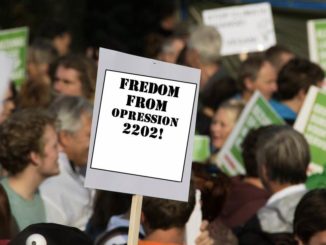
A while back, we took some time to explain logical fallacies to Mennonites. Today, we’re going to look at something a little different: cognitive biases. These are the psychological shortcuts your mind takes that can lead to errors in perception and decision making. Should be helpful at the next elder board meeting. Let’s have a look at a few of them yet.
- anchoring bias – this is how people tend to focus too much, or get hooked, on the first piece of information they receive. So, say, Mr. Plett is trying to buy some chickens from that nice Hutterite lady in the parking lot at the Co-ops. Mr. Plett asks her “how much yet for the chickens?” Mrs. Waldner is smart, so she starts high, “$23” she says. Now that $23 has been anchored in Mr. Plett’s mind, they negotiate back and forth and eventually settle not too far from Mrs. Waldner’s price. The lesson: always anchor your price first or you might overpay for chickens.
- backfire effect – People don’t like to lose arguments, so try as you might, no matter what evidence you provide, you’re unlikely to convince your opponent. Instead, it might even backfire, convincing them even more that they are correct. No matter how many verses you find to support your post-trib position, your buddy Abe fires back with verses that seem to suggest pre-trib. This goes back and forth until you’re both steaming mad and more convinced than ever that whenever the rapture occurs it’s certain your friend will not be among those taken away.
- the bandwagon effect – Oh, Mennonites love this one! It’s just like it sounds. This is how people tend to adopt ideas and trends more readily when they are popular with others. Mennonites are slow to change, but after a while things start to snowball and the next thing you know the church is using one of those new-fangled overhead projectors!
- blind spot bias – Well, now, this is the tendency to think other people are more biased than you are, or to see other people’s biases but not your own. It’s kind of like how Mr. Loewen always notices if Mrs. Kehler’s duak is not on properly, but never seems to notice that his fly has been open all morning.
- choice-supportive bias – After we make a decision, we tend to find reasons why our decision was the right one. Instead of looking at things fairly, we just find evidence that we were right. So, for example, Mr. Fehr bought a used buggy from Thrifty Jake’s Buggies and More. When he brought it home, he realized it wasn’t in quite the pristine condition that Thrifty Jake had led him to believe. Mr. Fehr regrets his decision, but doesn’t want to feel like he made a bad choice, so he spends the next three weeks convincing himself it’s actually a pretty good buggy and “who needs springs in your seat, anyway. Those are just worldly!” Eventually he stops thinking about what a bad choice he made and even buys another buggy from Thrifty Jake in the future.
- confirmation bias – this is the tendency to seek out information that confirms what you already believe. So, for example, Mrs. Wiebe believes that summa borscht is better for you than komst borscht, so she spends all her days at one of the computers at the Jake Epp Library looking for “top ten reasons why summa borscht is healthy” or “why komst borscht is just no good yet.” With searches like that, she’s bound to confirm her borscht biases.
- placebo effect – The belief that something has an effect can create the effect. This applies to medicine, say, Mrs. Unger being absolutely convinced in the healing powers of her trajchtmoaka. It can also apply to Opa Peters’ belief that black licorise can cure all ills, or Oma Braun’s undying commitment to chicken soup with star anise.
- rhyme as reason effect – Strange as it sounds, studies have shown that people are more likely to believe sayings that are told in rhyme. Remember “if it doesn’t fit, you must acquit”? Or the Mennonite classic: “A Lutheran to marry? A Baptist to wed? Better to marry cousin Heinrich instead.”
- stereotyping – This is a generalization about a group of people that may not actually apply to each individual within that group. For example, it’s a stereotype that Mennonites don’t dance. However….Oh, wait that one’s true. Nevermind…
- survivorship bias – As humans we tend to seek out examples for inspiration. We might think that it’s easy to become a movie star because of all the stars who’ve made it in Hollywood. But we only see the “survivors.” We don’t see the thousands of people who never made it in Hollywood and ended up back on the hog farm near Kleefeld or working at the A&W out by Deacon’s Corner.




